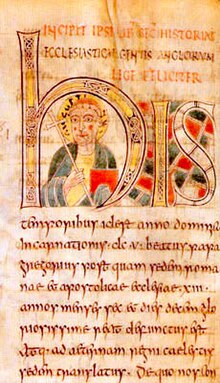Augustine | |
|---|---|
| Archbishop of Canterbury | |
 Portrait labelled "AUGUSTINUS" from the mid-8th century Saint Petersburg Bede, though perhaps intended as Gregory the Great.[a] | |
| Diocese | Canterbury |
| See | Canterbury |
| Appointed | Before 601 |
| Term ended | Probably 26 May 604 |
| Predecessor | None |
| Successor | Laurence of Canterbury |
| Other post(s) | Prior of Abbey of St Andrew's |
| Orders | |
| Consecration | c. 597 |
| Personal details | |
| Born | early 6th century, probably in Italy |
| Died | probably 26 May 604 Canterbury, Kingdom of Kent |
| Buried | St Augustine's Abbey, Canterbury |
| Sainthood | |
| Feast day | 26 May (Anglican,[3] Eastern Orthodox, and Catholic Extraordinary Form calendar in Great Britain) 27 May (Catholic Ordinary Form calendar) 28 May (Catholic Extraordinary Form calendar outside Great Britain) |
| Venerated in | |
| Canonized | Pre-congregation |
| Shrines | |
Augustine of Canterbury (early 6th century – most likely 26 May 604) was a Christian monk who became the first archbishop of Canterbury in the year 597. He is considered the "Apostle to the English".
Augustine was the prior of a monastery in Rome when Pope Gregory the Great chose him in 595 to lead a mission, usually known as the Gregorian mission, to Britain to Christianize King Æthelberht and his Kingdom of Kent from Anglo-Saxon paganism. Kent was likely chosen because Æthelberht commanded major influence over neighbouring Anglo-Saxon kingdoms in addition to his marriage to Bertha, a Frankish princess, who was expected to exert some influence over her husband. Before reaching Kent, the missionaries had considered turning back, but Gregory urged them on, and in 597, Augustine landed on the Isle of Thanet and proceeded to Æthelberht's main town of Canterbury.
King Æthelberht converted to Christianity and allowed the missionaries to preach freely, giving them land to found a monastery outside the city walls. Augustine was consecrated as a bishop and converted many of the king's subjects, including thousands during a mass baptism on Christmas Day in 597. Pope Gregory sent more missionaries in 601, along with encouraging letters and gifts for the churches, although attempts to persuade the native British bishops to submit to Augustine's authority failed. Roman bishops were established at London, and Rochester in 604, and a school was founded to train Anglo-Saxon priests and missionaries. Augustine also arranged the consecration of his successor, Laurence of Canterbury. The archbishop probably died in 604 and was soon revered as a saint.
- ^ Schapiro "Decoration of the Leningrad Manuscript of Bede" Selected Papers: Volume 3 pp. 199, 212–214
- ^ Dales "Apostle of the English" L'eredità spirituale di Gregorio Magno tra Occidente e Oriente p. 299
- ^ "The Calendar". The Church of England. Retrieved 27 March 2021.
Cite error: There are <ref group=lower-alpha> tags or {{efn}} templates on this page, but the references will not show without a {{reflist|group=lower-alpha}} template or {{notelist}} template (see the help page).